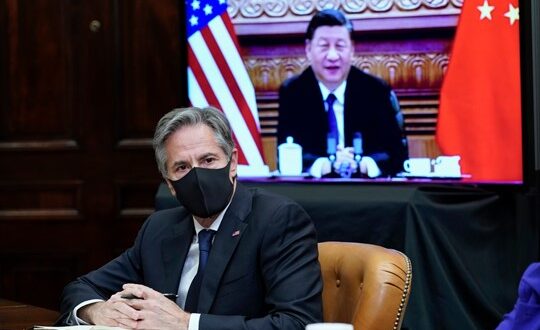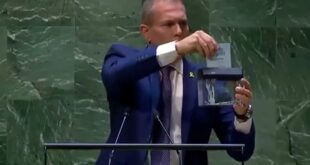Much has already been said about the recent heightening of U.S.-China tensions and its potential fallout. What gets less attention is how the U.S. and China themselves perceive the status of their relationship, and how that affects their plans for the future. An analysis of prevailing elite opinion in the U.S. and China—starting with reactions to the Nov. 16 virtual summit between U.S. President Joe Biden and Chinese leader Xi Jinping—can shed light on how each side understands the root causes of the current competition, and why they believe they can overcome them.
For the United States, the rivalry is driven by China’s challenge to U.S. power and leadership, as well as its belief that Beijing is trying to alter the international order for its own benefit. For Beijing, it is driven by the United States’ continued “hegemonic” pretensions amid what Chinese elites see as its inevitable decline.
While both Washington and Beijing believe that their relationship will be primarily defined by competition rather than cooperation for the foreseeable future, there are nonetheless indications that both states are hoping to protect themselves by establishing new “guardrails” to provide strategic stability, even as they continue to compete with one another. But doing so will be difficult.
A Study in Contrasts
Both the U.S. and China framed the Biden-Xi virtual summit of Nov. 16 as a “polite” but “straightforward” exchange on major areas of contention. Yet a comparison of the two sides’ readouts of the discussion also demonstrates that each country has a fundamentally different understanding of their positioning relative to one another, in addition to their divergent objectives.
The White House statement is brief, comprising a mere four paragraphs. It begins by noting that Biden and Xi acknowledged the “importance of managing competition responsibly,” framed by an understanding of where their “interests align,” and where their “interests, values, and perspectives diverge.” According to the White House, the U.S. and China align on climate change; on regional security challenges such as those posed by Afghanistan and North Korea; and on “managing strategic risks” in the bilateral relationship. In particular, Biden emphasized the need for “common-sense guardrails to ensure that competition does not veer into conflict and to keep lines of communication open.”
From there, the Biden team devoted far more attention to the divergences, naming specific topics like Taiwanese sovereignty, ongoing trade disputes and human rights violations in Xinjiang, Tibet and Hong Kong. The memo is prefaced with the statement that the U.S. would “continue to stand up for its interests and values and, together with our allies and partners, ensure the rules of the road for the 21st century advance an international system that is free, open, and fair.” For the United States, then, the defense of its “interests and values” is inextricably bound to the future of a “free, open and fair” international order.
Biden’s team sees stabilizing the U.S.-China relationship as a significant part of its broader efforts to restore U.S. global leadership and revitalize U.S. power after the chaos of former President Donald Trump’s term. More importantly, the readout underscores the fact that Biden sees China as an obstacle to achieving those goals.
Beijing’s readout, which is much longer, also notes areas of shared interest like climate change and expresses a desire to establish “guardrails.” While “it is only natural that China and the United States have differences,” the statement says, both share an interest in “constructively” managing relations to “avoid expansion and intensification” of disagreements.
But the Chinese readout also bears stark contrasts to that of the Biden administration, particularly when it comes to three issues: its view on China’s current global status, its conceptions of international order and its assessment of U.S. intentions.
According to Beijing, both countries already share global leadership.First, Beijing repeatedly emphasizes a fundamental equality of status and role between the U.S. and China. The opening paragraph claims that “as the world’s top two economies and permanent members of the U.N. Security Council,” Beijing and Washington “should strengthen communication and cooperation,” not only for the benefit of their own citizens, but to “also shoulder our due international responsibilities.” According to Beijing, then, both countries already share global leadership.
Second, Beijing disputes the implication that China is trying to spread its authoritarian system of government to other countries, thereby posing a challenge U.S. values and interests, as well as the broader international order. It asserts that while China’s development and modernization is an “inevitable historical trend,” China “has no intention of selling its own path to the world.” Instead, Beijing says it would encourage other countries “to find a path of development that suits their national conditions.”
Rather than an international order defined by “interfering in the internal affairs of other countries through human rights issues,” as the Chinese readout puts it, China’s preference, according to Xi, is for both China and the U.S. to “safeguard … an international order based on international law and basic norms of international relations” that derive from the “purposes and principles of the U.N. Charter.”
This reflects Beijing’s historical emphasis on the U.N. Charter’s guarantees of non-interference and state sovereignty over its guarantees of human rights, the tabling of which it portrays as an instrument by which the U.S. is trying to stifle China’s rise.
Third, the Chinese readout quotes Biden as stating:
China was already a great power 5,000 years ago. I want to reiterate clearly that the U.S. does not seek to change China’s system of governance, does not seek to counter China through alliances and has no intention to have conflict with China. The U.S. government is devoted to pursuing the long-standing One China policy, does not support Taiwan independence and hopes that the Taiwan Strait will remain peaceful and stable.
This quote does not appear in the White House version, and Biden’s team has not confirmed or denied its accuracy. Nonetheless, its inclusion is significant, because it sheds light on what China would like to hear from the United States: recognition of China’s great power status; assurances that the U.S. does not seek to overthrow the ruling Chinese Communist Party or go to war with China; and assurances that the U.S. still abides by the One China policy, which Beijing frames as supporting Chinese sovereignty over Taiwan.
A Struggle for Two Orders
In light of these differences, how should tensions between the U.S. and China be managed? The views of each country’s foreign policy specialists can provide some clues here. What is striking is that they tend to be mirror images of one another, suggesting that “strategic competition” may remain the default posture for the foreseeable future.
Over the past four years, a consensus position has gradually emerged among U.S. foreign policy specialists on China—one that, taking into account China’s capabilities, intentions and domestic trajectory, advocates the necessity for a tougher U.S. response. Washington’s current assessment, as seen in the Pentagon’s recent China Military Power Report, is that China’s military capabilities have put it in a position to challenge U.S. power and revise the international order in line with its national interests—and that Beijing plans on doing so.
For many analysts, this shift in Chinese policy can be correlated to Xi Jinping’s consolidation of power since 2013, when he began serving as the country’s president, in addition to his roles as general secretary of the CCP and chairman of the Central Military Commission, and became the country’s paramount political leader. Under him, the CCP began its assertive pursuit of the “great rejuvenation of the Chinese nation” and the reassertion of muscular, authoritarian controls over Chinese society.
In this reading, China’s emergence as a powerful, ambitious and repressive state will lead to the development of “a new international order that would make the world less free and less safe,” unless the United States responds. As Orville Schell argued in The Wire, this view has led to the “death of engagement” as the organizing principle of U.S. relations with China. Engagement—that optimistic, neoliberal, post-Cold War consensus that China’s increased involvement in the existing international order would have a pacifying and liberalizing effect, mitigating the potential for strategic conflict—has been replaced by the open rhetorical and legislative embrace of “strategic competition.”
The problem, as multiple critics have rightly noted, is that strategic competition is not a strategy. It does not align means and ends, and as a result, it does not illuminate a path forward for the U.S. to further its interests. At best, it is a “bumper sticker” rebrand of U.S. foreign policy. American foreign policy specialists—much like the Trump and Biden administrations—broadly agree about the nature of the problem the United States faces, but have not yet settled on a solution.
In China, meanwhile, foreign policy specialists’ views about engagement with the U.S. have gone through several stages since the 1990s, each of which corresponded to a different view on what U.S. “hegemony” means for China.
During the 1990s, the consensus view was that China had to marshal its “comprehensive national power” to resist U.S. pressure during Washington’s “unipolar moment.” In the subsequent decade, after the 9/11 terrorist attacks, Chinese analysts began to see the key inflection points of the era—the global war on terrorism, the 2003 Iraq War and the 2008 global financial crisis—as opportunities for China to take advantage of Washington’s distraction. Beijing began to embrace a strategy of “peaceful rise,” with rhetoric assuaging regional concerns about its intentions.
The next shift, toward a more proactive approach, came during Xi Jinping’s first term as China’s president, starting in 2013. Under the overall goal of “national rejuvenation,” Beijing sought to harness Chinese power to build a “community of common destiny,” allowing it to shape the international order. During this time, some Chinese foreign policy specialists claimed not only that the U.S. was in decline, but that so too was “hegemony” as an ordering principle of international relations. This view made it possible to present Xi’s proposed “community of common destiny” concept not as China’s own hegemonic project, but as a vision for a more pluralistic world that would replace U.S. hegemony.
Finally, in the past five years, during Xi’s second term, Chinese elites have realized that Washington would not go quietly into the night. Instead, they began to see the U.S. as a “declining” hegemon lashing out at its supposed challengers. The “conventional wisdom,” as the influential foreign policy specialist Wang Jisi noted, now holds that the U.S. is “driven by fear and envy to contain China in every possible way,” making it “the greatest external challenge to China’s national security, sovereignty and internal stability.” In this sense, Chinese specialists frame their country as being in a struggle for “two orders”: the domestic order, which would be secured through continued CCP rule, and the international order, where China needs to defend against efforts to limit its influence.
Chinese elites began to see the U.S. as a “declining” hegemon lashing out at its supposed challengers. This view of U.S. aggression was clearly expressed in Chinese analysts’ assessments of the Biden-Xi summit. Zhao Minghao, for instance, described a U.S. that, “having failed to win the trade war,” is now “maliciously” playing the Taiwan card to “interrupt China’s peaceful rise through a war.”
Others, like Wang Honggang, note that while Biden appears more interested in multilateralism than Trump, the “beginning and end of the Biden administration’s strategic thinking is still to preserve American hegemony.” He argues that the Biden administration is seeking to signal that it “has strength” out of fears that the Trump years damaged the United States’ credibility and influence. In fact, he argues, it is a “weak government.”
Finally, Huang Renwei of Fudan University has argued that U.S.-China relations are following the three phases of war identified in “On Protracted War,” Mao Zedong’s 1938 treatise: strategic defense, strategic stalemate and the strategic counteroffensive. According to Huang, U.S.-China relations are currently in the phase of “strategic stalemate” and may stay there for some time, since the U.S. “does not have the ability and will to devote all its resources to the confrontation with China, thus limiting the scale of the confrontation.” That gives China the upper hand, Huang says, because if the U.S. “continues to intensify its efforts against China over a period of time, its expended resources and costs will overwhelm the U.S. itself, at which point the strategic stalemate will shift in China’s favor.”
The Implications of Strategic Stalemate
These crucial differences between the U.S. and Chinese views also lead both countries to fundamentally different perspectives on how the competition can—or should—be resolved.
As Biden told Congress last April, the U.S. objective is a whole-of-nation effort to “out compete” China in order to “win the 21st century.” The administration believes its success in this competition is tied to “the foundations of U.S. strength,” holding that “only relative American advantages will produce security, and losing the lead will compromise U.S. interests.” Still, though the Biden administration may have committed rhetorically to rebuilding the international order, it has in fact been preoccupied with strengthening the military aspects of American power.
For Beijing, the prevailing view that the U.S. is lashing out informs its reactions to U.S. criticisms on all manner of issues—from human rights abuses in Xinjiang to COVID-19—with Beijing frequently noting that China must be protected from unfair or malicious treatment by the U.S. Yet at the same time, Chinese analysts believe that time is on China’s side, and that U.S. efforts to “out compete” China will only hasten its own decline.
It is still possible that Washington and Beijing will find a way to move from strategic competition to a “competitive coexistence,” with guardrails in place to ward off conflict. Even if the short-term chances of them striking such a balance seem low, the longer-term prospects should not be discounted, especially since both parties have a shared interest in reaching stability.
And yet, the fundamental divergence between the United States’ view of the bilateral relationship and that of China makes clear that achieving coexistence will be neither quick, nor easy.
 Eurasia Press & News
Eurasia Press & News




